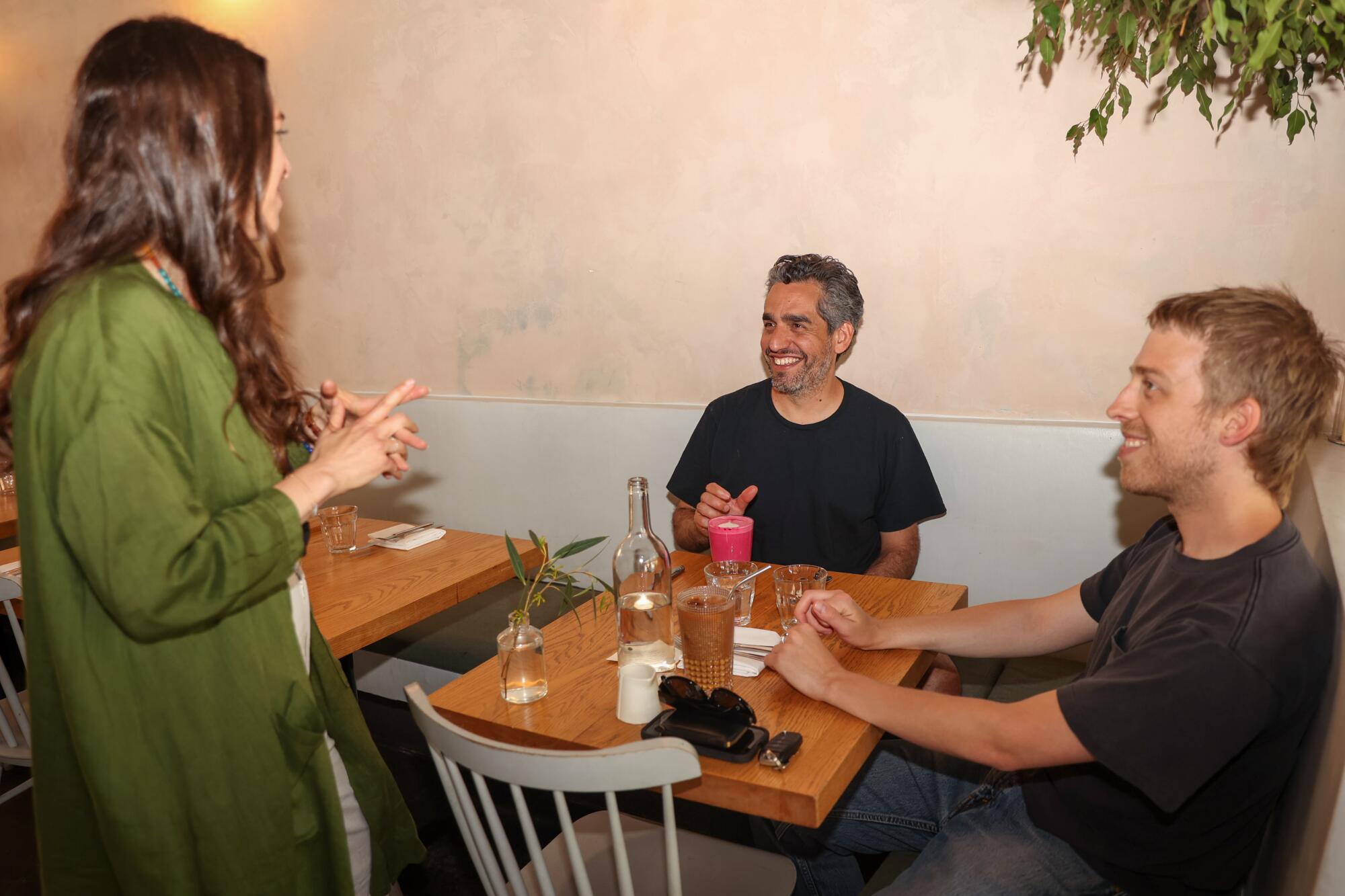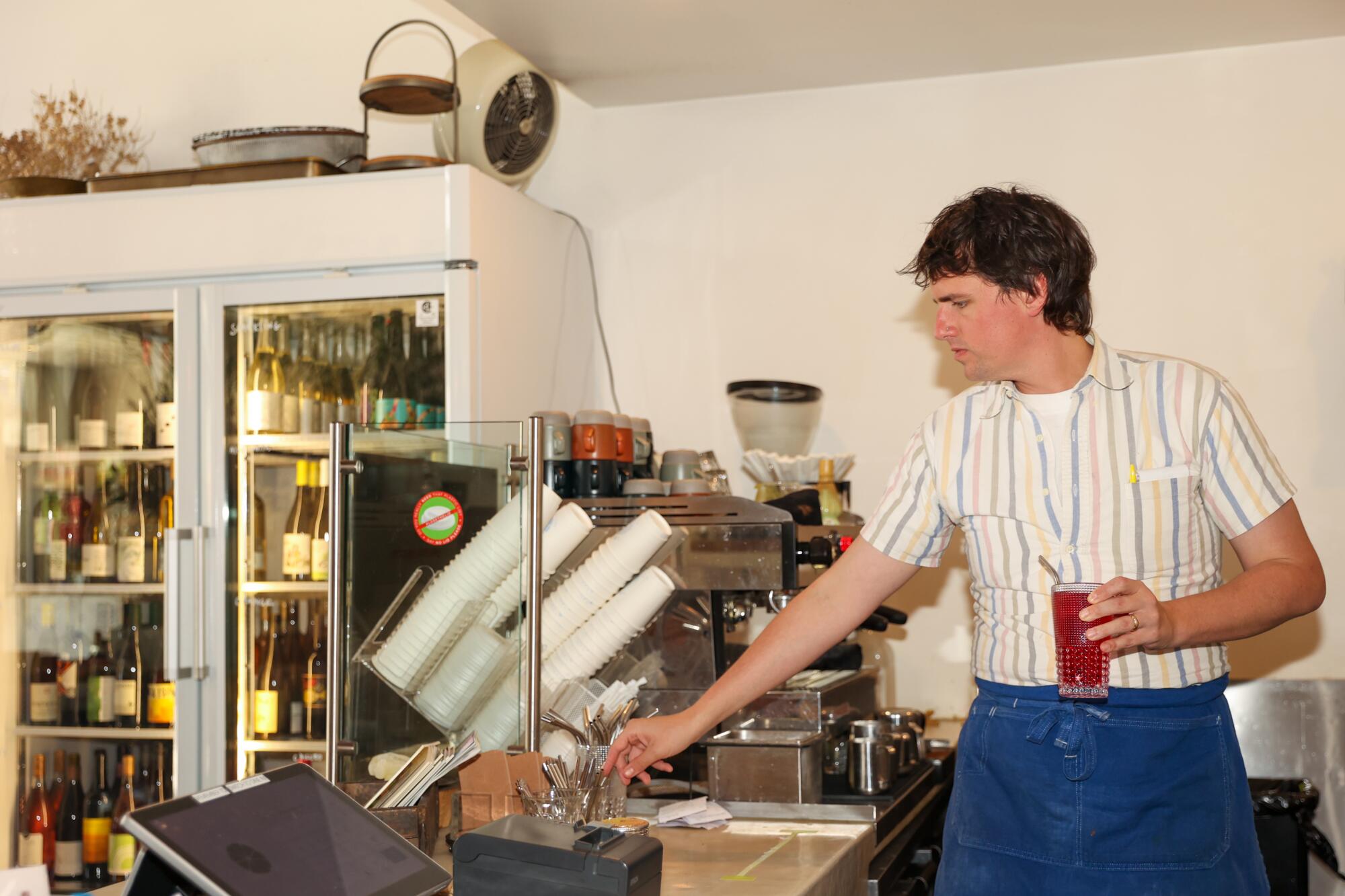Business
Where every cent of $1 goes at one L.A. restaurant, explained

My industry has always been as difficult as it is magical. In the post-pandemic era, challenges are categorically higher.
The threat to restaurants during the pandemic was obvious; it was a given that many wouldn’t come out the other side. In 2024, restaurants are back! No, restaurants are dying! No, restaurants are (sometimes) busy! It is whiplash, day to day.
For many, including my restaurant, Botanica, solvency is more elusive than ever due to the elevated cost of doing business. Since opening Botanica nearly seven years ago, our labor costs have risen 40% for hourly workers and 25% for salaried management, the result of minimum-wage increases and market-rate pay increases. Our rent has risen 17%. Our sales, on the other hand, have grown only 2.3%.
Obviously, this creates a near-impossible status quo. In our industry, there are no mechanisms for alleviating costs other than trimming spending on goods and labor.
In other words: There is no way to balance the books without compromising the quality, vision and values that define a business like ours. There are no tax breaks on costly insurance policies or credit card processing fees. And if we were to pass the costs on to our customers, we’d be compromising the vision and values that make us what we are. It’s an absolute conundrum.
Our way of doing business is under threat. From frequent conversations with restaurateur friends (including my co-founders of Regarding Her, a nonprofit focused on female food-industry leaders), I know that what Botanica is navigating at the moment is far from unique.

Botanica co-owner Heather Sperling at her restaurant in Silver Lake. For many restaurants, “Solvency is more elusive than ever due to the elevated cost of doing business.”
(Michael Blackshire / Los Angeles Times)
Why does this matter? Neighborhood-oriented restaurants are vital to communities and economies. They are meaningful gathering spots and dependable local employers. They support numerous other businesses: cleaners, farmers, coffee roasters, winemakers, equipment technicians, etc. They’re small and personal, and thus are approachable and accountable in ways that larger businesses aren’t. They’re often run by owners and managers who care deeply about their people, their neighborhood and their impact — even more than they care about their bottom line.
I know this because Emily Fiffer (Botanica’s co-owner) and I are among these people. And, moreover, we’re friends with dozens of like-minded owners across L.A. and beyond.
Eating at a place like Botanica might feel indulgent. Dishes on the spring menu range in price from $14 for marinated bean toast $36 for Baja striped bass. But from our perspective, the purpose of our business is not just to provide a nice evening of beautifully prepared, local, sustainable produce and natural wine. Our goal is to run a business with the most positive possible impact on our community, economy and environment — a business that embodies what we call “nourishing hospitality.”
There’s an economic concept called “the multiplier effect,” which describes how the effect of spending is greater than the original money spent. While every dollar you spend ripples through the economy in some way, restaurants surely must provide among the best bang for your buck, so to speak.
So one day I sat down to try to calculate exactly how this works with our model, and I landed on a startling figure.
Of every $1 spent by a customer at Botanica in 2023, $1.005 went back out the door.
Of that, 86.7 cents went toward “the good stuff” — meaning people, businesses and causes that it feels good to be supporting; 53.2 cents pays for the livelihoods of 50 staff members (including insurance, benefits and hefty payroll taxes); 26.2 cents buys products from a sensational web of farmers, purveyors and makers doing ethical, sustainability-focused work, who themselves employ countless passionate individuals; and 7.3 cents pays for a cadre of small businesses in supporting roles: our cleaning crew, florist, laundry services, a cavalcade of local equipment repair people, the family-run supplier of our recyclable and compostable to-go and market packaging, and so on.

Two diners share a spread during tinned-fish happy hour at Botanica restaurant in Silver Lake.
(Michael Blackshire / Los Angeles Times)

The tinned fish display at Botanica. The restaurant also has a market stocked with house-made goods and products from local, largely women-owned businesses.
(Michael Blackshire / Los Angeles Times)
And then 13.8 cents goes to occupancy costs (rent, utilities and trash/recycling/compost pickup); administrative costs (office supplies, our accountant, various apps and tools essential to operations, phone and internet, etc.); and the cost of credit card processing — 3.1 cents I really wish we could spend elsewhere!
The national average profit margin for independent restaurants is regularly cited to be in the zone of 3% to 5% (sometimes higher, often lower). This profit is necessary for retaining staff (raises), reinvesting in infrastructure (endless property and equipment repairs), navigating snafus (a power outage can result in thousands of dollars in losses), and repaying the investors, often friends and family, who funded the venture in the first place.
Botanica closed out 2023 with a 1.19% profit — but not from restaurant operations; those were just slightly less than break-even. Our revenue was boosted by a handful of commercial photo shoots held at the restaurant on days when we were closed.
Granted, Botanica is a more labor-heavy model than many in our cohort. We are open for breakfast, lunch and dinner; we have a robust coffee/tea/bakery program, and the front of our space is a market stocked with natural wine, house-made goods and products from local, largely women-owned businesses. These are laborious undertakings that require substantially more staff (with specialized training, no less) than a dinner-only joint. But these elements of our business, costly as they may be, are the ones that make us an especially useful, multifaceted neighborhood spot.

Botanica is open for breakfast, lunch and dinner. Sperling drops by a table to chat with customers Zal Batmanglij, center, and Blake Holland, right.
(Michael Blackshire / Los Angeles Times)
All this is to say that a restaurant like Botanica — like so many other independent, owner-operated neighborhood restaurants across the country — exists, first and foremost, to nourish its people. Hospitality is innately altruistic, and the neighborhood restaurant is especially, preciously, precariously so.
I don’t have any grand solutions to propose, though I do believe that low-margin, financially uncertain businesses like ours will need structural support to continue to exist. That 3.11% of revenue that goes to credit card processing fees ($98,725 last year, paid to our point-of-sale system, Toast) would be a transformational addition to our bottom line. And I’d vastly prefer to reinvest some of the 4.89% that went to payroll taxes ($155,000 in 2023) into our team.
In the absence of legislated solutions, it comes down to the diners. Nearly 20 years ago, right as I was starting out in the food world, Michael Pollan introduced the concept of “voting with your fork” via his seminal book “The Omnivore’s Dilemma”; it’s his way of succinctly expressing the importance and power that your daily food choices can have.

Botanica’s marketplace also sells natural wines, along with its selection of house-made goods and local products.
(Michael Blackshire / Los Angeles Times)

A server prepares a drink at Botanica. Co-owner Sperling says that since opening the restaurant almost seven years ago, labor costs have risen 40% for hourly workers and 25% for salaried management.
(Michael Blackshire / Los Angeles Times)
I’ve been trying to come up with a corollary that relates to the restaurant world — “dining with your values” doesn’t have the same ring to it; my suggestion box is wide open! — as a way to convey what it means to support restaurants not just for the creative/buzzy/exciting food they serve but for the broader philosophy that informs their work and exponentially impacts their small corners of the world.
Because for us to keep doing what we do, we need your support — and your understanding of the positive ripple effect that your support has. I hope this encourages you to feel good about your next brunch/dinner/coffee/cocktail outing at a thoughtful, community-minded restaurant near you.
It means more than you may know.
Heather Sperling is the co-founder and co-owner of Botanica, a restaurant and market in Silver Lake, Los Angeles.

Business
After 57 years of open seating, is Southwest changing its brand?

Jim Kingsley of Orange County, who recently flew Southwest on a two-leg journey from Minneapolis to Los Angeles, likened the budget-friendly airline to In-N-Out Burger.
Both brands are affordable, consistent and more simplistic compared with competitors, Kingsley said.
“They’re not trying to offer all the things everybody else offers,” he said, “but they get the quality right and it’s a good value.”
Change, however, is in the air.
Southwest, which since its founding nearly 60 years ago has positioned itself in the cutthroat airline industry as an easygoing, egalitarian option, upended that guiding ethos this week with word that it would get rid of its famous first-come, first-seated policy in favor of traditional assigned seats and a premium class option. They will also offer overnight, red-eye flights in five markets including Los Angeles.
Experts say the changes, especially the switch to assigned seating, are a smart move and will appeal to many as the company tries to stabilize its precarious finances that included a 46% drop in profits in the second quarter from a year earlier to $367 million. But it remains to be seen whether Southwest will pay an intangible cost in making the moves: Will it be able to hold on to its quirky identity or will it put off loyal customers, and in doing so, become just another airline?
“You’re going to hear nostalgia about this, but I think it’s very logical and probably something the company should have done years ago,” said Duane Pfennigwerth, a global airlines analyst at Evercore.
“In many markets away from core Southwest markets, we think open seating is a boarding process that many people avoid,” he said.
That is all well and good, but “I didn’t ask for these changes,” Kingsley said. “Cost and quality is what I care about.”
Open seating has its pros and cons, Kingsley said, though he’s generally a fan. On his trip to Los Angeles, his group wasn’t able to get seats all together. But he likes that preferred seats are available on a first-come, first-served basis, instead of being offered for a high price.
Eighty percent of Southwest customers and 86% of potential customers prefer an assigned seat, the airline said in a statement.
“By moving to an assigned seating model, Southwest expects to broaden its appeal and attract more flying from its current and future customers,” the airline said.
An even bigger draw of Southwest, according to Kingsley, is its policy of including two free checked bags per ticket. This perk often makes Southwest a better bargain, especially for longer trips or bigger groups, he said.
The free bags are a big deal to customers, experts said, and contribute to the airline’s consumer-friendly brand. The airline hasn’t indicated they plan to change their bag policy.
“Southwest has always had a really good, positive vibe,” said Alan Fyall, chair of Tourism Marketing at the University of Central Florida’s College of Hospitality. “It’s free bags, good prices and point-to-point routes. That’s what they stand for and that’s what people love about them.”
Southwest’s change to assigned seating doesn’t mean they’re no longer a budget-friendly airline, Fyall said, but it does differentiate them from the lowest-cost, lowest-amenity options such as Frontier and Spirit.
The move will also require Southwest to update all or a portion of its fleet to include first-class seats. Currently, all seats on a Southwest flight are identical. Fyall said it’s worth the investment.
It’s an appropriate time for Southwest to make adjustments, said Chris Hydock, an assistant professor at Tulane University’s Freeman School of Business.
“They’ve not been profitable the last couple of quarters and they’ve had some activist investor pressure to increase their revenue,” he said.
Costs such as wages and maintenance have risen across the airline industry even as travel increased after the pandemic. Southwest saw a net loss of $231 million in the first quarter of 2024. Wall Street analysts estimate that assigned, premium seating could boost revenue by $2 billion per year.
“This is one of the options where they could potentially increase their revenue and do something that a lot of consumers have a strong preference for anyway,” Hydock said.
For Southwest’s changes to pay off, it has to stick to its roots when it comes to its culture and brand, experts and travelers agreed.
“I love Southwest being different,” Kingsley said. “If they’re trying to be like the other airlines, I think they’re shooting themselves in the foot.”
Business
Column: 99 years after the Scopes 'monkey trial,' religious fundamentalism still infects our schools

Almost a century has passed since a Tennessee schoolteacher was found guilty of teaching evolution to his students. We’ve come a long way since that happened on July 21, 1925. Haven’t we?
No, not really.
The Christian fundamentalism that begat the state law that John Scopes violated has not gone away. It regularly resurfaces in American politics, including today, when efforts to ban or dilute the teaching of evolution and other scientific concepts are part and parcel of a nationwide book-banning campaign, augmented by an effort to whitewash the teaching of American history.
I knew that education was in danger from the source that has always hampered it—religious fanaticism.
— Clarence Darrow, on why he took on the defense of John Scopes at the ‘monkey trial’
The trial in Dayton, Tenn., that supposedly placed evolution in the dock is seen as a touchstone of the recurrent battle between science and revelation. It is and it isn’t. But the battle is very real.
Let’s take a look.
The Scopes trial was one of the first, if not the very first, to be dubbed “the trial of the century.”
And why not? It pitted the fundamentalist William Jennings Bryan — three-time Democratic presidential candidate, former congressman and secretary of State, once labeled “the great commoner” for his faith in the judgment of ordinary people, but at 65 showing the effects of age — against Clarence Darrow, the most storied defense counsel of his time.
The case has retained its hold on the popular imagination chiefly thanks to “Inherit the Wind,” an inescapably dramatic reconstruction — actually a caricature — of the trial that premiered in 1955, when the play was written as a hooded critique of McCarthyism.
Most people probably know it from the 1960 film version, which starred Frederic March, Spencer Tracy and Gene Kelly as the characters meant to portray Bryan, Darrow and H.L. Mencken, the acerbic Baltimore newspaperman whose coverage of the trial is a genuine landmark of American journalism.
What all this means is that the actual case has become encrusted by myth over the ensuing decades.
One persistent myth is that the anti-evolution law and the trial arose from a focused groundswell of religious fanaticism in Tennessee. In fact, they could be said to have occurred — to repurpose a phrase usually employed to describe how Britain acquired her empire — in “a fit of absence of mind.”
The Legislature passed the measure idly as a meaningless gift to its drafter, John W. Butler, a lay preacher who hadn’t passed any other bill. (The bill “did not amount to a row of pins; let him have it,” a legislator commented, according to Ray Ginger’s definitive 1958 book about the case, “Six Days or Forever?”)
No one bothered to organize an opposition. There was no legislative debate. The lawmakers assumed that Gov. Austin Peay would simply veto the bill. The president of the University of Tennessee disdained it, but kept mum because he didn’t want the issue to complicate a plan for university funding then before the Legislature.
Peay signed the bill, asserting that it was an innocuous law that wouldn’t interfere with anything being taught in the state’s schools. The law “probably … will never be applied,” he said. Bryan, who approved of the law as a symbolic statement of religious principle, had advised legislators to leave out any penalty for violation, lest it be declared unconstitutional.
The lawmakers, however, made it a misdemeanor punishable by a fine for any teacher in the public schools “to teach any theory that denies the story of the Divine Creation of man as taught in the Bible, and to teach instead that man had descended from a lower order of animal.”
Scopes’ arrest and trial proceeded in similarly desultory manner. Scopes, a school football coach and science teacher filling in for an ailing biology teacher, assigned the students to read a textbook that included evolution. He wasn’t a local and didn’t intend to set down roots in Dayton, but his parents were socialists and agnostics, so when a local group sought to bring a test case, he agreed to be the defendant.
The play and movie of “Inherit the Wind” portray the townspeople as religious fanatics, except for a couple of courageous individuals. In fact, they were models of tolerance. Even Mencken, who came to Dayton expecting to find a squalid backwater, instead discovered “a country town full of charm and even beauty.”
Dayton’s civic boosters paid little attention to the profound issues ostensibly at play in the courthouse; they saw the trial as a sort of economic development project, a tool for attracting new residents and businesses to compete with the big city nearby, Chattanooga. They couldn’t have been happier when Bryan signed on as the chief prosecutor and a local group solicited Darrow for the defense.
“I knew that education was in danger from the source that has always hampered it — religious fanaticism,” Darrow wrote in his autobiography. “My only object was to focus the attention of the country on the programme of Mr. Bryan and the other fundamentalists in America.” He wasn’t blind to how the case was being presented in the press: “As a farce instead of a tragedy.” But he judged the press publicity to be priceless.
The press and and the local establishment had diametrically opposed visions of what the trial was about. The former saw it as a fight to protect from rubes the theory of evolution, specifically that humans descended from lower orders of primate, hence the enduring nickname of the “monkey trial.” For the judge and jury, it was about a defendant’s violation of a law written in plain English.
The trial’s elevated position in American culture derives from two sources: Mencken’s coverage for the Baltimore Sun, and “Inherit the Wind.” Notwithstanding his praise for Dayton’s “charm,” Mencken scorned its residents as “yokels,” “morons” and “ignoramuses,” trapped by their “simian imbecility” into swallowing Bryan’s “theologic bilge.”
The play and movie turned a couple of courtroom exchanges into moments of high drama, notably Darrow’s calling Bryan to the witness stand to testify to the truth of the Bible, and Bryan’s humiliation at his hands.
In truth, that exchange was a late-innings sideshow of no significance to the case. Scopes was plainly guilty of violating the law and his conviction preordained. But it was overturned on a technicality (the judge had fined him $100, more than was authorized by state law), leaving nothing for the pro-evolution camp to bring to an appellate court. The whole thing fizzled away.
The idea that despite Scopes’ conviction, the trial was a defeat for fundamentalism, lived on. Scopes was one of its adherents. “I believe that the Dayton trial marked the beginning of the decline of fundamentalism,” he said in a 1965 interview. “I feel that restrictive legislation on academic freedom is forever a thing of the past, … that the Dayton trial had some part in bringing to birth this new era.”
That was untrue then, or now. When the late biologist and science historian Stephen Jay Gould quoted that interview in a 1981 essay, fundamentalist politics were again on the rise. Gould observed that Jerry Falwell had taken up the mountebank’s mission of William Jennings Bryan.
It was harder then to exclude evolution from the class curriculum entirely, Gould wrote, but its enemies had turned to demanding “‘equal time’ for evolution and for old-time religion masquerading under the self-contradictory title of ‘scientific creationism.’”
For the evangelical right, Gould noted, “creationism is a mere stalking horse … in a political program that would ban abortion, erase the political and social gains of women … and reinstitute all the jingoism and distrust of learning that prepares a nation for demagoguery.”
And here we are again. Measures banning the teaching of evolution outright have not lately been passed or introduced at the state level. But those that advocate teaching the “strengths and weaknesses” of scientific hypotheses are common — language that seems innocuous, but that educators know opens the door to undermining pupils’ understanding of science.
In some red states, legislators have tried to bootstrap regulations aimed at narrowing scientific teaching onto laws suppressing discussions of race and gender in the classrooms and stripping books touching those topics from school libraries and public libraries.
The most ringing rejection of creationism as a public school topic was sounded in 2005 by a federal judge in Pennsylvania, who ruled that “intelligent design” — creationism by another name — “cannot uncouple itself from its creationist, and thus religious, antecedents” and therefore is unconstitutional as a topic in public schools. Yet only last year, a bill to allow “intelligent design” to be taught in the state’s public schools was overwhelmingly passed by the state Senate. (It died in a House committee.)
Oklahoma’s reactionary state superintendent of education, Ryan Walters, recently mandated that the Bible should be taught in all K-12 schools, and that a physical copy be present in every classroom, along with the Ten Commandments, the Declaration of Independence and the Constitution. “These documents are mandatory for the holistic education of students in Oklahoma,” he ordered.
It’s clear that these sorts of policies are broadly unpopular across much of the nation: In last year’s state and local elections, ibook-banners and other candidates preaching a distorted vision of “parents’ rights” to undermine educational standards were soundly defeated.
That doesn’t seem to matter to the culture warriors who have expanded their attacks on race and gender teaching to science itself. They’re playing a long game. They conceal their intentions with vague language in laws that force teachers to question whether something they say in class will bring prosecutors to the schoolhouse door.
Gould detected the subtext of these campaigns. So did Mencken, who had Bryan’s number. Crushed by his losses in three presidential campaigns in 1896, 1900 and 1908, Mencken wrote, Bryan had launched a new campaign of cheap religiosity.
“This old buzzard,” Mencken wrote, “having failed to raise the mob against its rulers, now prepares to raise it against its teachers.” Bryan understood instinctively that the way to turn American society from a democracy to a theocracy was to start by destroying its schools. His heirs, right up to the present day, know it too.
Business
NASA identifies Starliner problems but sets no date for astronauts' return to Earth

After weeks of testing, NASA and Boeing officials said Thursday they have identified problems with the Starliner’s propulsion system that have kept two astronauts at the International Space Station for seven weeks — but they didn’t set a date to return them to Earth.
Ground testing conducted on thrusters that maneuver Boeing’s capsule in space found that Teflon used to control the flow of rocket propellant eroded under high heat conditions, while different seals that control helium gas showed bulging, they said.
The testing was conducted after the thrusters malfunctioned when Starliner docked with the space station on June 6 and a helium leak that was detected before launch worsened on the trip to the station. The helium pressurizes the propulsion system.
However, officials said the problems should not prevent astronauts Suni Williams and Butch Wilmore from returning to Earth aboard the Starliner capsule, which lifted off on its maiden human test flight June 5 for what was supposed to be an eight-day mission.
“I am very confident we have a good vehicle to bring the crew back with,” Mark Nappi, program manager of Boeing’s Commercial Crew Program, said at a news conference.
NASA and Boeing officials have said previously that the Starliner could transport the astronauts to Earth if there were an emergency aboard the space station, but they opted to conduct the ground tests to ensure a safe, planned return.
Decisions on whether and when to use Starliner or another vehicle will be made by NASA leaders after they are presented next week with all the information collected from the testing, which will include a “hot fire” test of the engines of the Starliner docked at the space station, Nappi said.
Rigorous ground testing conducted at NASA’s White Sands Test Facility on a thruster identical to the ones on the Starliner found that, despite the issues with Teflon degradation, the thruster was able to perform the maneuvers that would be needed to return Starliner to Earth, said Steve Stich, program manager for NASA’s Commercial Crew Program.
Official also have said that the Starliner still has about 10 times more helium than is needed to bring the capsule back to Earth.
The problems that have cropped up have been an embarrassment for Boeing, which along with SpaceX was given a multibillion-dollar contract in 2014 to service the station with crew and cargo flights after the end of the space shuttle program. Since then, Elon Musk’s Hawthorne-based company has sent more than a half-dozen crews up, while Boeing is still in its testing phase — with the current flight delayed for weeks by the helium leak and other issues that arose even before the thrusters malfunctioned.
Should NASA make a decision not to bring the crew home on the Starliner — which could still return to Earth remotely — the astronauts could be retrieved by SpaceX’s Crew Dragon capsule, though SpaceX’s workhorse Falcon 9 rocket is currently grounded after a failure this month.
The Russian Soyuz spacecraft also services the station and carries American astronauts.
-

 World1 week ago
World1 week agoOne dead after car crashes into restaurant in Paris
-

 Midwest1 week ago
Midwest1 week agoMichigan rep posts video response to Stephen Colbert's joke about his RNC speech: 'Touché'
-

 News1 week ago
News1 week agoVideo: Young Republicans on Why Their Party Isn’t Reaching Gen Z (And What They Can Do About It)
-

 Movie Reviews1 week ago
Movie Reviews1 week agoMovie Review: A new generation drives into the storm in rousing ‘Twisters’
-

 News1 week ago
News1 week agoIn Milwaukee, Black Voters Struggle to Find a Home With Either Party
-

 Politics1 week ago
Politics1 week agoFox News Politics: The Call is Coming from Inside the House
-

 News1 week ago
News1 week agoVideo: J.D. Vance Accepts Vice-Presidential Nomination
-

 World1 week ago
World1 week agoTrump to take RNC stage for first speech since assassination attempt















